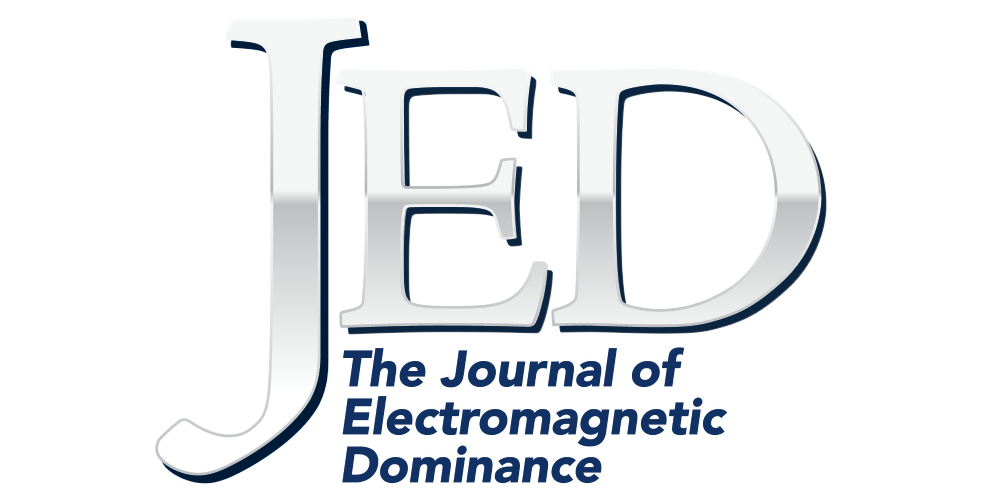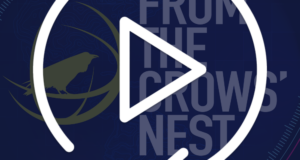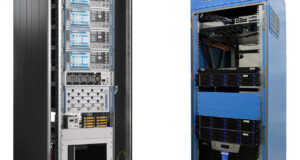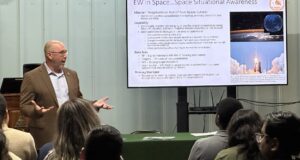FTCN Replay: Celebrating the Next Generation of EW Leaders
The Association of Old Crows (AOC) recently highlighted four of its 2024 Future 5 Award recipients on a special episode of From the Crows’ Nest, the podcast hosted by AOC Director of Advocacy and Outreach, Ken Miller. These honorees — Imani Davis, Matthew Copeland, Paul Kennedy and Michael Gutierrez — represent a new generation of talent driving innovation and impact in Electromagnetic Spectrum Operations (EMSO).
This year’s cohort brings together professionals from government, academia, startups and defense industry giants. Despite their different paths, all share a commitment to solving some of the most complex challenges in electronic warfare, cyber integration and R&D collaboration.
“We’re often chasing a golden goose—one perfect solution. But sometimes you need something that does one thing very well, not everything okay.”
—Matthew Copeland, C5ISR Center
Bridging Cyber and EW: A Call for Convergence
Imani Davis, a cyber software engineer at NSWC Crane, emphasized the need to bridge the gap between electronic warfare and cyber operations. After beginning her career in Huntsville, Alabama, Davis transitioned into EW through Crane’s Spectrum Warfare Department, quickly becoming a cyber subject matter expert on mission analytics programs.
“If we can model cyber effects in force-level EW mission planning, we’ll make leaps and bounds in how we support operators and planners.”
—Imani Davis, NSWC Crane
To address the cyber-EW gap, Davis spearheaded workforce development initiatives — providing offensive and defensive cyber training to EW engineers using tools like TryHackMe. Her efforts aim to equip the next generation with a unified skillset.
Matthew Copeland, who also started in Huntsville and now supports the Army’s C5ISR Center, echoed Davis’ focus on convergence. His early work leveraged AI modeling through the Arma 3 gaming environment to simulate EMSO scenarios. Today, he’s focused on refining R&D efforts and creating better alignment between technical development and operational outcomes.
“There’s a disconnect between R&D and program managers. When ideas get filtered up the chain, critical context often gets lost.”
—Matthew Copeland
Breaking Barriers in the Acquisition and Innovation Pipeline
The discussion also turned toward structural hurdles. Both Davis and Copeland cited bureaucratic delays, siloed funding and slow feedback loops as major obstacles to innovation.
“If we’re serious about keeping pace with threats, we need funding mechanisms that support rapid innovation—not six-month delays.”
—Imani Davis
Paul Kennedy, a project manager at Johns Hopkins University’s Applied Physics Laboratory, added that new frameworks like open standards (e.g., SOSA) are opening doors for smaller contributors and accelerating collaboration across the defense ecosystem. However, he cautioned that the test and evaluation community must keep pace with the speed of prototyping.
“Being able to work on critical challenges independently is intellectually freeing. The mission impact keeps me motivated every day.”
—Paul Kennedy, JHU APL
Startups, Hackathons and Entrepreneurial Vision
Michael Gutierrez, co-founder of the defense startup CX2, brings a unique entrepreneurial perspective to the Future 5 cohort. A graduate of Columbia University, Gutierrez previously interned with Palantir and Epirus, where he worked on high-powered microwave weapons. Now, he’s focused on building aerial defense systems and scaling dual-use technologies in EMSO.
“The North Star is always delivering effective capabilities to the warfighter. That’s what drives me.”
—Michael Gutierrez, CX2
Gutierrez is also known for organizing large-scale defense hackathons in New York and California, bringing together hundreds of engineers and military professionals for rapid innovation exercises. His work underscores the value of public-private collaboration.
“We wanted a forum where people weren’t just building lightsabers — they were solving real problems that warfighters face.”
—Michael Gutierrez
Mentorship: A Common Thread Across All Paths
As the episode wrapped, each honoree reflected on the role of mentorship in their professional development. Whether it was Davis’ experience guiding her first interns or Copeland’s initiative to start a SEMA club outside of work, all expressed gratitude for those who helped them—and a desire to give back.
“Mentors got me into the right rooms at the right times. Now I try to do the same for the next generation.”
—Matthew Copeland
“Seeing young engineers light up with new ideas—it’s incredibly rewarding.”
—Imani Davis
Kennedy highlighted family influence and support from AOC’s Chesapeake Bay Roost as vital to his development, while Gutierrez spoke to the impact of mentors who offered honest feedback and opened doors for high-impact opportunities.
“The best students come from the best teachers. And the best mentors raise the bar—not just once, but continuously.”
—Michael Gutierrez
2024 Future 5 Honorees:
- Matthew Copeland, Electronics Engineer, DOD – C5ISR Center – RTI – CEMA Division – IOEW Branch
- Imani Davis, Computer Scientist, Naval Surface Warfare Center, Crane Division
- Michael Gutierrez, Software Engineer, Palantir Technologies, Inc.
- Paul Kennedy, Section Supervisor, Johns Hopkins University Applied Physics Laboratory
- Paul Wilkowski, Senior Specialist, Systems Engineer, L3Harris Technologies (Wilkowski was not available to participate in the episode.)
These professionals are not just building careers — they’re shaping the future of EMSO, one innovation, one connection and one idea at a time.
To hear the full conversation, listen to the Future 5 episode of From the Crows’ Nest on your favorite podcast platform. Don’t forget to subscribe, share and complete the listener survey to claim your free podcast T-shirt.
Start listening:





